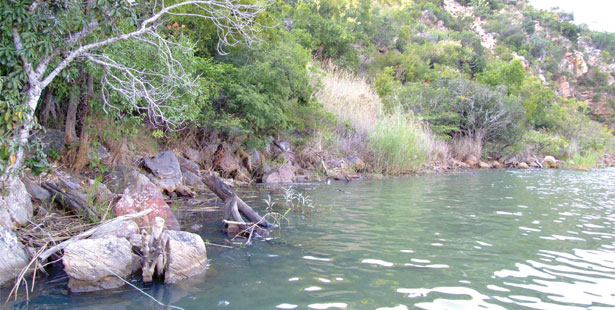
On a recent outing that started as the dawn brought a pale blush to the horizon, we had enjoyed moderate success and by the time eleven o’ clock came around we were quite satisfied with our efforts. Time for a break, but it had to be in some shade – we are no longer able, or willing, to withstand the bright sun despite lashings of sunscreen and shady hats (too many pale spots and blotches that signify skin cancers).
Instead of turning the boat towards our launch site we instead headed for the welcoming band of shade cast by a steep, cliff area. There we tied up against some small shrubs that had found a break in the sheer rock walls and settled back with our cooldrinks. Feeling quite refreshed after our mid morning break, why, we asked ourselves, must we go back to the obvious bass holding cover and structures that we had fished earlier on? What was so wrong with where we already were?
Several years ago we had enjoyed a hectic trip to the States and on one of those huge impoundments in Texas our guide had headed straight for what looked like ten storey buildings rising steeply out of the water on the one shoreline. It was an intimidating sight, and we questioned our guide’s intention for going there mainly because it was just about devoid of any vegetation. The water also looked pretty deep.
“Most folks avoid places like this for exactly the reason you have mentioned,” he answered us,
”but bass can and will relate to them – all along the cliff face there are small alcoves and caves where fodder fish find hiding and comfort zones, and that is where savvy old bass also hang out,” he pointed out. “You’ll also find crabs and other creatures living in amongst the rock and that also attracts bass,” he added.
We recalled that the water was far too deep for our guide to anchor the boat, so that morning we were introduced to “drift fishing a rock face”. He first of all determined the wind direction and took the boat upwind and about fifteen feet from the cliff. Then he had us cast our baits – 1/8 and ¼ ounce jigs – ahead of the boat and as tight to the rock face as possible on a slack line to allow them to sink vertically. He used the gentle breeze to drift the boat along, using the sneaker only to provide steerage. The tactic was to allow the jig to settle almost on the bottom and then to retrieve it using a twitch and bounce action, all the while trying to keep the line as taut as possible. This tactic made it possible to get the baits into all the possible strike zones and did deliver a fair share of fish, including a fine eight pounder.
We used the same tactic later on using spinnerbaits, letting them spiral down to a few feet off the bottom before starting the retrieve. In our logbooks the entries show that most of the bass were caught while the spinnerbait was on the drop. The reason for not allowing them to hit the bottom was because, as our guide explained, the chances of a hang up on the bottom were too great.
At another spot, with similar steep cliffs and rock faces but with much shallower water, our guide was able to anchor the boat in about thirty feet of water. The tactic here was to position the boat right up against the cliff face and to cast spinnerbaits parallel to it. It made for some “interesting’ casting as the angler on the furthest side of the boat to the cliff face had a clear shot, while the partner on the near side did not. So the casting was done in tandem – first the angler on the open side, then the angler on the near side, all the while changing position on the casting deck – definitely not a tactic for beginners!
So on the morning in question we decided to imitate what we had learnt so many years ago, and even though the cliff faces were not nearly as high as those we had encountered in Texas, the tactics did deliver some bass.
One additional factor that can make fishing such sheer cliff faces and rock walls productive is that in South Africa we have species such as mudfish and barbs that feed on the moss and slime that tends to gather on the rocks. These are very much on the bass’ menu and where you encounter this phenomenon are sure signs that bass will be around as well.
Because such areas are mostly devoid of any vegetative cover anglers may be excused for thinking that lighter than usual tackle may be used, but this is not so. Rocks tend to have sharp edges and it pays to size up on what you normally use. A good sized bass caught in such situations will do its best to escape and you don’t want a struggling bass on a light line in amongst such structures!
Our bait of choice when fishing cliffs and steep rock faces is the jig, and we will fish it until we are convinced that the bass do not want a jig on a particular day, although we must admit that this is a rare occurrence. Second on our list is the spinnerbait and its modern versions, while we will also fish the range of soft plastics such as grubs, worms and creature baits. We also use various sinker weights to determine what sink rate the bass prefer on a given day, and on the jigs we most often add sweeteners such as pork rind or curly tail grubs, particularly when the water is deeper than six feet.
Steep cliff faces and rock walls have definitely got more going for them than mere places where one can escape the sun’s rays!


 Visit us our
Visit us our